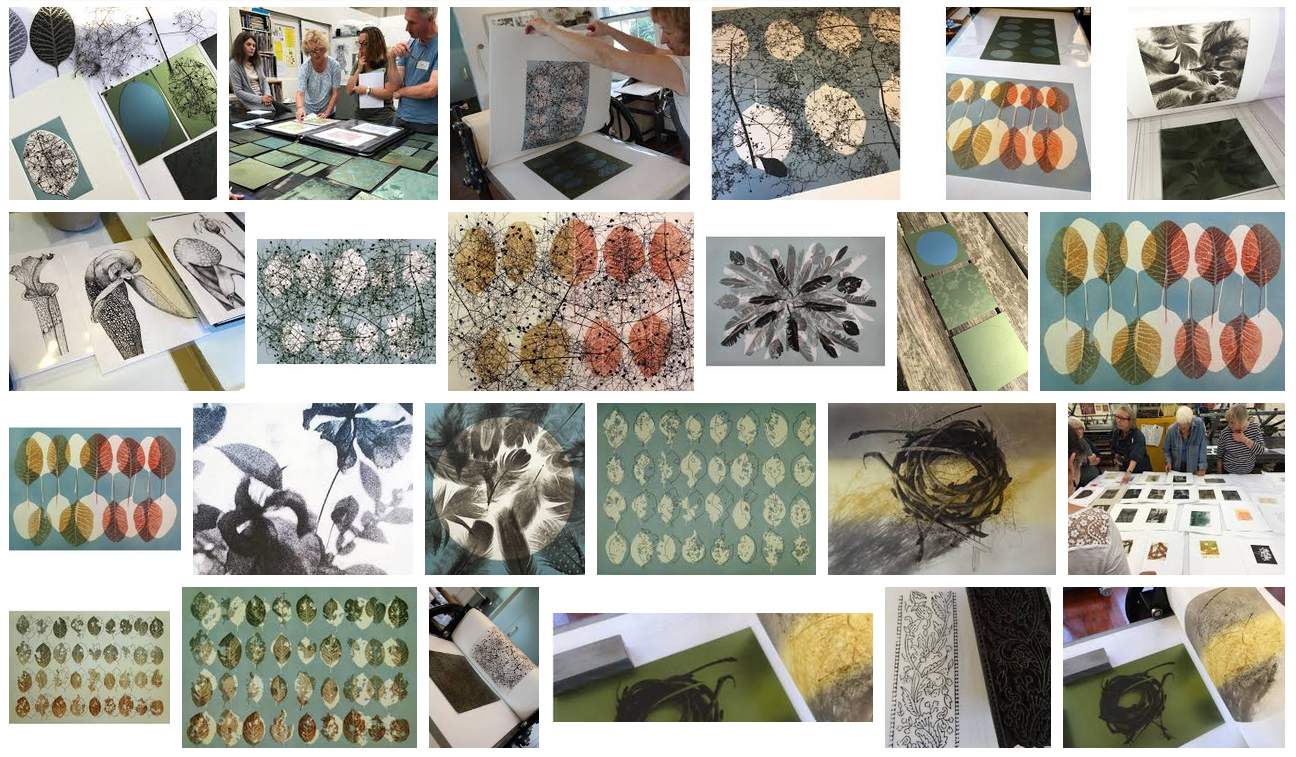‘Solar Plate’ is the popular name for Photopolymer plates which can be used to make fine relief or intaglio printing plates. These plates are thin (usually steel) sheets coated with a light-sensitive transparent plastic layer. When exposed to UV (including bright sunlight) the light-sensitive plastic hardens and becomes insoluble to water. Areas not exposed to the UV stay water-soluble and can be washed away with tapwater and a soft scrubbing brush.
A wide range of designs can be transferred to the photopolymer plate and, depending on the contrast of he original and the way the plate is prepared, it can then be used for either relief or intaglio printing.
The result is often described as ‘acid-free etching’ since it can achieve a fantastically wide range of texture, tone and line work without the use of any hazardous chemicals or processes.
Transferring ‘line work’ (ie solid areas of colour) is most straightforward and usually involved just one sequence of exposure/washing/hardening. The results can then be printed relief or combined with extra pressure to do fine and shallow blind embossing. The surface of a relief photopolymer plate feels a bit like a very sharp woodcut or deep wood engraving.
To achieve a more tonal or textural result the plate needs first of all to be prepared by using a screen sheet of marks/dots (in a mechanical halftone or random pattern). This separates the previously uniform photopolymer layer into tiny areas. The prepared plate can then be exposed to a piece of tonal artwork which combines with the screening to render the tones as different sizes of dots or marks (similar to a Mezzotint or Aquatint effect). The plate is then washed and hardened as before but the result is more like a fine toned etching and can be printed intaglio to give a remarkably sensitive textural or tonal print.
Susie Turner
East Anglian Artist Susie Turner has a very nice website showing how she uses Photopolymer plates to combine intaglio, inked relief and blind embossing, using a mixture of natural objects like leaves combined with drawn and semi-abstract forms. Susie also runs professional classes in the technique. Here is a selection from Google of images of Susie’s printmaking process and finished work:
Kate Watkins
South Coast artist printmaker Kate Watkins did a very concise blog post earlier this year on how to make an effective test plate. She realised that the combined exposure settings made a great difference to how much density and tonal detail the photopolymer plates would reproduce. Have a look at her blog now…
Photopolymer is in fact one of many techniques which use light and chemical processes to create high quality printing plates but is special in that it does not use any toxic chemicals, making it a uniquely versatile, safe and environmentally friendly process.
Background
US Printmaker Dan Welden is credited with developing this technology in the 1970’s as a simple and non-toxic alternative to acid etching. There’s some material explanatory on his website: http://www.danwelden.com/. Dan worked with many very accomplished American printmakers in the 80’s and 90’s applying this technique to high quality fine art editions.
Here are two recent YouTube videos of Dan Welden explaining the process of making and printing from Photopolymer plates:
Solar Plate / Cormorants image: Artwork to plate (halftone screen) and inking
https://www.youtube.com/watch?v=X346IoA2af0
Solar Plate / Desert Tortoise image: Inking and printing
https://www.youtube.com/watch?v=eWW-ZlLSN6M
…and he has also compiled some notes on what Solar Plate is and how to use it:
http://solarplate.com/what-is-solarplate/
http://solarplate.com/how-to/
The ‘Non-toxic print’ website ( http://www.nontoxicprint.com ) has some interesting articles and examples of traditional and experimental print processes including Solar Plate:
http://www.nontoxicprint.com/solarplate.htm
http://www.nontoxicprint.com/drypoint.htm
http://www.nontoxicprint.com/intagliotype.htm
..and here are some fairly straightforward notes on how to use Photopolymer plates:
http://www.imcclains.com/productinfo/documents/BasicInstructionsforPrintmakingwithSolarplates.pdf
Suppliers of Photopolymer plates
TN Lawrence stock Solar Plates:
https://www.lawrence.co.uk/product/solar-plate
Intaglio Printer stock a wide range of Photopolymer plates:
http://intaglioprintmaker.com/category/photopolymer-plates


